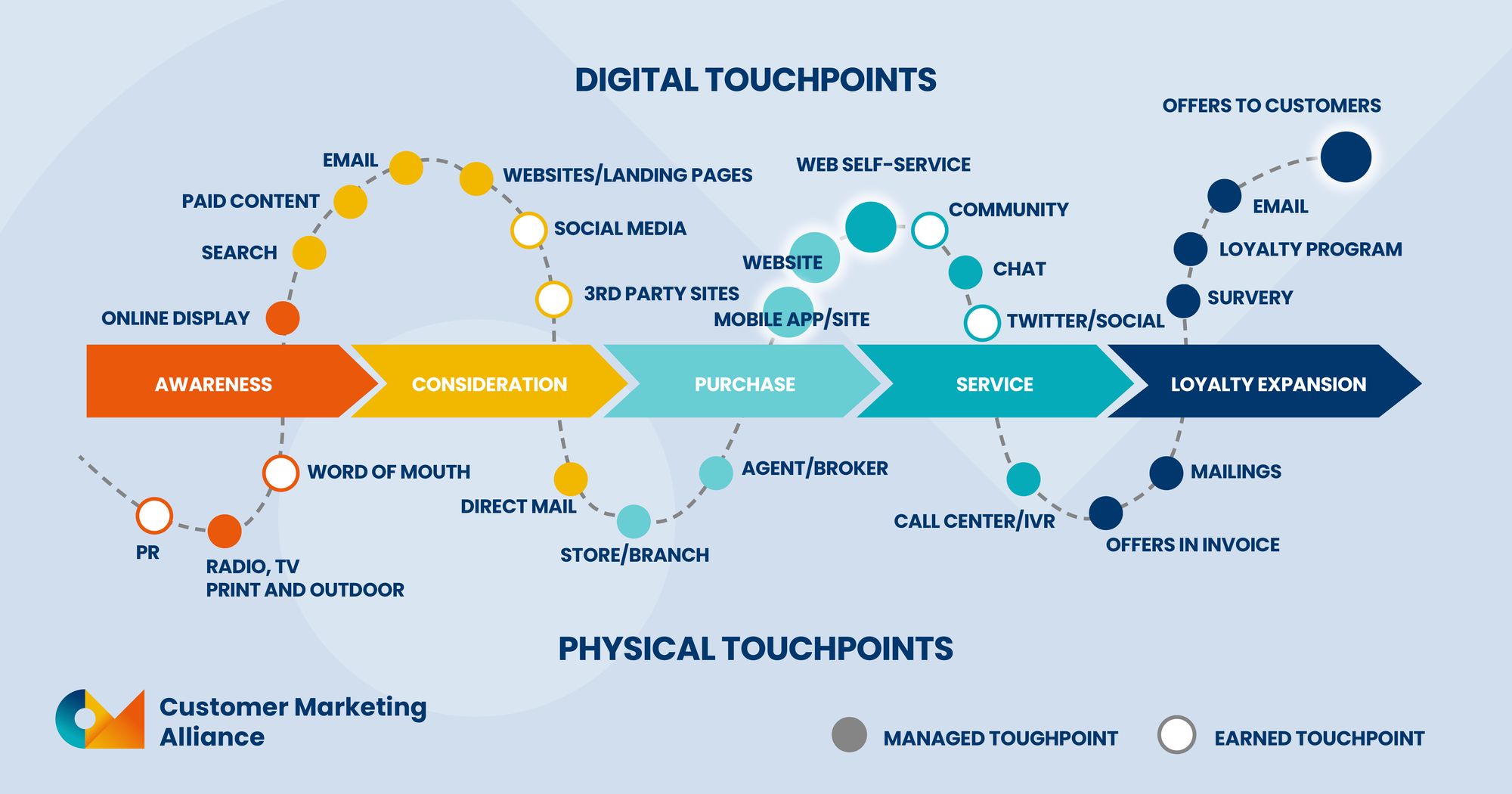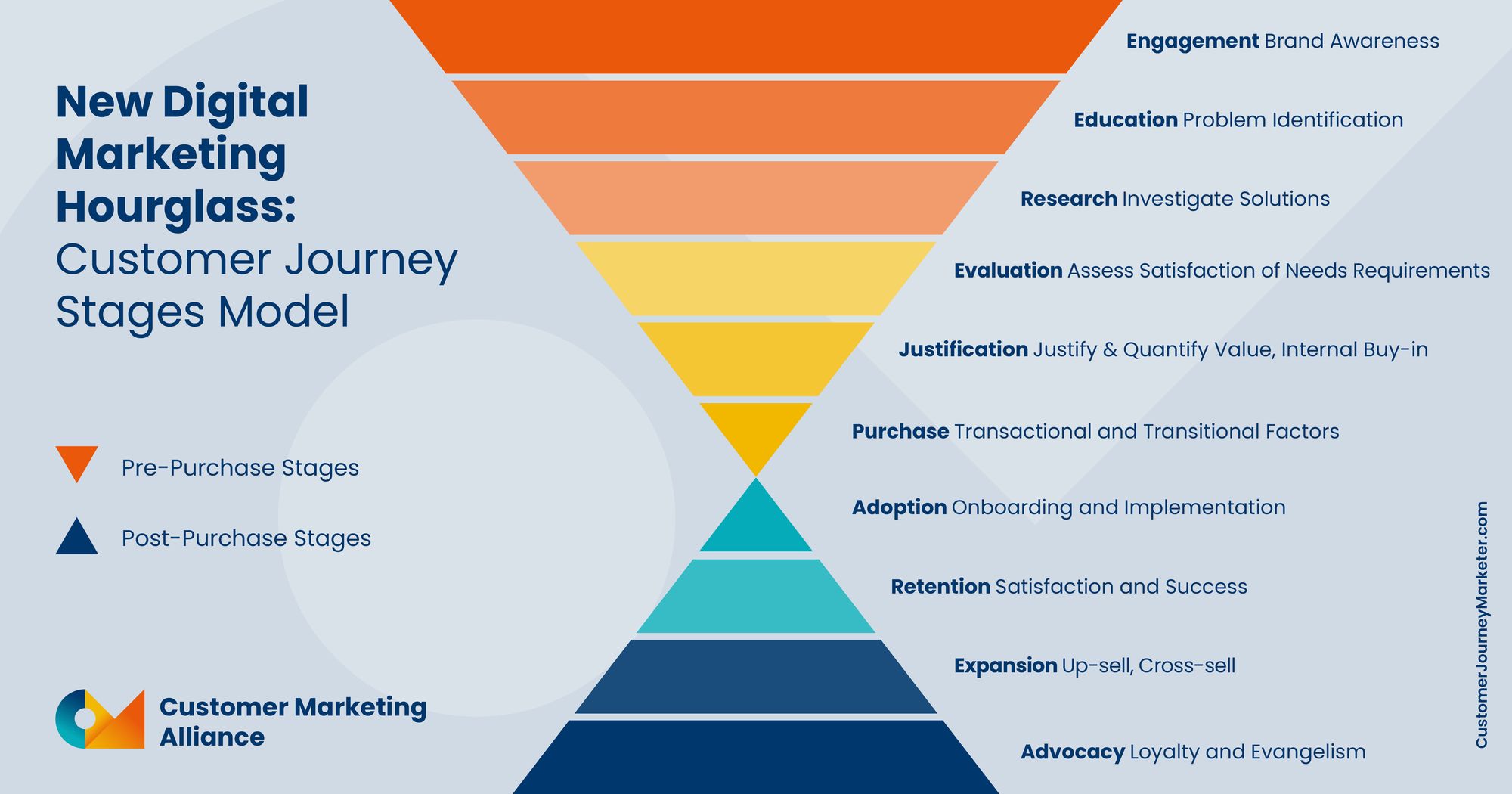The customer journey is typically a visual representation of a user’s journey with an organization, and how they interact with it at various points over time and across channels.
It may explore the emotions that arise in the user, and on which channels these emotions may occur as these interactions unfold. This article serves as an introduction to the customer journey and key areas of interest to customer marketing.
In this article you’ll find:
- An overview of what the customer journey looks like,
- Its relevance to customer marketing,
- How to approach customer journey mapping, and
- The possible challenges it can present.
Our Customer Marketing Industry and Salary Survey is out now, and is waiting for customer marketing MVPs like you to share your insights! Take the survey and help our research today.
The customer journey
Although often represented in linear form, the reality is that there are often cycles or skipping across the course of the customer journey.
It’s worth mentioning that each consumer will approach this journey differently. This is why personas are at the heart of how customer journeys work; they should be mapped specifically to a particular persona, as customer behavior and touchpoints will vary.
Generally speaking, the starting point is the moment that a potential customer becomes aware of the product or service.
The customer journey aims to understand the point of view of the customer and how they experience an organization. They enable understanding of any pain points, how the consumer arrived at these points, and reveal opportunities for intervention.
Interestingly, as Georgia Watson, Sales Enablement at IBM points out, even in the buying stage, customers increasingly value experience over anything else - with 85% for B2B , and 79% for B2C customers.
The journey might also reveal how an organization maps out their ‘to do’s’. They chart a path of possible actions that align with a given type of customer and visualize how a customer may engage with particular channels or content and how individuals or teams can respond.
They also chart frameworks that may be invisible to the customer. For example, processes connected to email nudges on customer onboarding triggers. They enable teams to design specific services across the journey to reduce friction at any identified pain points along the way.

Initially, consumers sequentially move through the awareness and consideration stages. For example, a prospect may encounter a brand via a quick Google search or word of mouth.
Next, in the consideration stage, they weigh up the brand, and any other contenders, against alternative solutions, before seeking out reviews, case studies or product demos in the decision-making phase.
These stages are typically quite complex for the consumer, and how they go about them will vary depending on the persona identified. As you can see on the graphic, there are a range of channels and touchpoints - and depending on the nature of the purchase involved, could be physical, digital, or a combination of these. After careful evaluation and justification, the consumer will buy the product and move into the ‘service’ stage as a paid customer.

As depicted in the graph above, an alternative way to look at the customer journey is to divide it into pre and post-purchase stages. This model is more explicit when it comes to the post-purchase stages.
Post-purchase flow
We can break down this post-purchase flow into the following processes:
- Adoption - setting up users for success, through content and monitoring
- Customer retention - fulfilling customer needs and giving them a reason to stay
- Expansion - connecting with and learning from customers, uncovering new solutions, identifying opportunities for upsell and cross-sell.
- Customer advocacy - activity connected to reviews, word of mouth recommendations, and so on, resulting in new prospects, leading to a constant loop rather than the end of the journey
Here’s where customer marketing really comes to the forefront.
In essence, mapping and refining the customer journey can further our understanding of the consumer, what’s influencing them, and predict what may happen next.
It also enables the creation of optimized and personalized experiences. As a customer marketer, knowing your personas’ journeys inside out, evolving with them, and ensuring that they’re full of magic moments that dazzle the customer is crucial. Having a customer journey mapped out also:
- Increases engagement
- Increases revenue
- Builds brand loyalty
- Saves time through automation
Depending on the structure of your team or set up of your organization, you may or may not have a hand in all of these stages or indeed the creation of the customer journey map.
The beauty of visualizing the customer journey, however, is that you can zoom in and out where needs be. You may want to map out specific flows such as onboarding or advocacy programs to optimize those areas for a particular persona or customer segment.
Next up, let’s look into some key action points when creating or mulling over the customer journey.
But first, consider downloading our ebook that covers the essential elements of a customer marketing plan. Fill out the form below to to learn six elements to build into your customer marketing plan, from the early stages to elements that’ll support you during growth and scale-up.
How to map the customer journey
There are so many different ways to bring the customer journey to life: some teams prefer to start on paper, with post-it notes and markers, others opt for a digital whiteboard, such as Miro.
Whichever way you choose to kick off, here’s our framework for getting started that can be tailored to the aims of your teams and organization.
Who are your customers?
Your personas are a great starting point here; they can give you a lot of information about the audience in front of you. For more information about personas, see our sister community, Product Marketing Alliance’s, dedicated personas module.
If this isn’t an option right now, focus on interviews, ethnographies and or surveys to get an idea of the interactions your customers are having and the touchpoints at hand.
Quantitative surveys can follow to confirm the results. Some companies also enlist the help of customers to aid in the mapping process. This can be especially helpful if you’re zooming in on a particular section of the journey, like onboarding or support.
For Saas companies, don’t forget to consider the multiple types of users that may interact with the product to find out which user may be involved and at what point.
The person that does the initial research will more than likely not be the one making purchase decisions. Therefore, it’s important to keep them in the front of your mind while mapping and considering touchpoints.
It’ll be useful to consider:
- Where do users use the tool?
- When do they use it?
- Do they use it collaboratively? Who with and what role do they have?
- Which functions are they using?
- What can we learn from how they are using them?
What are their goals?
It’s really important to know and understand your customer’s goals. They may impact how long a particular person spends on a particular process or stage. For instance: how much time they invest in the onboarding process or how much interest they will have in additional resources.
These goals may also evolve over time as customers develop their relationship with a company. Consider what problems they have that need to be solved. Goals can also impact the feature adoption of your product.
How do they feel?
Whether you’re in a B2B or B2C setting, considering how someone might feel at a particular point is invaluable. If you want to be truly customer-centric, you ought to be tuned into the emotions of your customers as they interact with us.
Whether it’s frustration or elation at the adoption stage or the warm fuzzy vibes that stem from a feeling of belonging to a brand community, it should be considered and give you insights into why people feel the way they do at a given point in time.
Mine your interviews or probe your customers for emotional insights. NPS (net promoter score) can also give a snapshot of how customers are feeling at a particular time and gauge their sentiment towards you.
What are the touchpoints?
It’s vital to get a handle on the sequence of events that a typical customer from a given persona might follow. These are your touchpoints, the moment in which a customer encounters your brand.
Some, of course, will be external and out of your control. Chris Ridson, the Design Director of Adaptive Path suggests that touchpoints should be:
- Appropriate
- Relevant
- Meaningful
- Endearing
To ensure that touchpoints are truly reflective of customer experience, talk to existing customers about the path they’ve taken, via roundtables or feedback. Make use of tools such as Hotjar which provides mapping and recordings of a user’s movements on websites - highlighting sections that are commonly visited, or conversely, ignored.
For instance, it may give insights into why a particular type of user may drop off a homepage or landing page after a few clicks. The information they were looking for probably wasn’t available or easily accessible, and key interactions were missed.
By switching up the page and testing different layouts and content, the number of exits or bounce rate can be reduced, as the target personas see content that is relevant and of value to them.
Also consider moments of truth. These are key points in which customers often form an opinion of your brand, and be sure to pay attention to them whether they’re good or bad.
Some common moments of truth typically occur earlier in the customer journey when users discover the value of your product. This might be in the onboarding process, or slightly further down the line when they truly integrate the product into their daily lives. Do some digging to find out when these ‘aha’ moments normally happen.
For example, imagine searching for a flight with a new airline. You find a few contenders, but the timing and services onboard with one particular company knocks it out of the park. The booking process and communications are fantastic. You check in, go about your usual pre-flight activities and wait to board.
After some time, a message appears on the monitor with ‘DELAY’. confronted with a huge line and no explanation as to why or how long it will take to check-in. You wait for an hour. An hour becomes two. Communication is non-existent. The moments of magic (great booking process and communications) are now long forgotten
Even though this may not be the airline’s fault, how they go about communicating the issue at hand is their remit. This negative moment of truth is likely to spill into not so favorable feedback, or possibly will be passed on to friends or family.
According to a Nielsen survey, eight out of ten customers say that completely or mostly trust recommendations from friends or family. Therefore, you need to consider where these key points fall in your customer journey mapping.
Do you deliver?
What do your customers believe you’re delivering and does it live up to your overall brand proposition? Whether your brand is sold as the fastest, most convenient, or the cheapest doesn’t really matter if your customers fail to see that supposed value.
This point is inherently tied to the last, and sketching out the customer journey can provide key insights into where this disappointment originates and where your brand could tighten up a touchpoint or a process.
Customer journey challenges
Some possible challenges lie ahead when mapping your customer journey. It can take a lot of skill to get everyone onboard the customer journey train. Bear in mind that the purpose of journey mapping is to uncover potential sticking points for customers, improve processes and enrich overall customer delight.
Therefore, ensure any areas for improvement are addressed. Like personas, customer journeys may change and evolve and could need updating if you’re seeing contradictions.
To learn more about these challenges, have a look into our Customer Marketing Certified course. Here you will learn more about the customer journey including:
🛤 Some customer journey best practices,
🎟 Introduction to the onboarding process and framework,
🎤 Tools to boost customer engagement, and
💛 A breakdown of customer advocacy and community.


